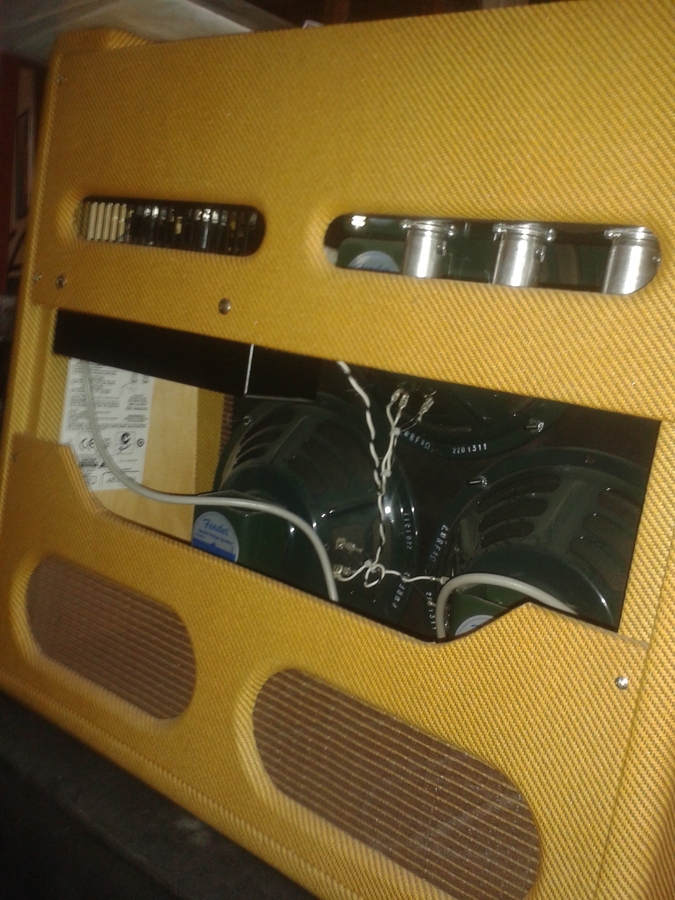
It brought back old memories of so many tunes. I didn't know too much about it and was pleasantly surprised at what I heard. I'm interested in the '57 Tweed Twin because of playing one briefly recently. I don't want this thread to turn into a vintage versus non-vintage cuss fight. Its all good, but its not stuff I would put up on a pedestal next to an authentic antique Twin. Yes, I've played the Victoria and also the Tungsten stuff. In my experience, the only tweed twin I have personally ever played that equaled an original great 50's one was a one-off home-brew clone built by a very good builder in Florida that was at the Tampa TonFest a few years ago- Shea Moxon's personal amp. Just as with guitars, not every example coming off of the line will be 'the one'. I belive its probably true that there may be just okay RI's and the occasionally brilliant example coming out of the shop. I know Chi a long time and I trust his experience and ears. Maybe they haven't played grail versions as I have. Maybe my standards for greatness are a bit higher than some of the other posters to this thread. I made it my business to check it out as soon as they became available. I was really excited when Fender announced an authentic point-to-point reissue.

I made a point of playing great old examples when ever I could, and there are a few I have encountered that are 'holy grail' examples. There are also examples that have been through the wars because they were players from day one and just got better as they got more beat up.Īs far as the Tweed Twin RI's- I've been a tweed twin fan since I saw Danny Gatton playing through his thirty years ago. There are some mint, as new with hang-tags 50 year-old guitars that were dogs when they were made, and remain so. It's important to understand what's goin' on before we mess with a "Holy Grail" tone.There is some classic gear that becomes ratty-ass and old as it ages, and other that ages to become a benchmark classic that may eclipse what it sounded like new. It's possible to "blueprint" an amp according to values published on the schematic and end up with something that sounds nasty. Some old parts drift to "sweet spot" values while others fade away to the "suck spot".

Start with a plain old 39k that's drifted 20% and we're very close to the "correct" 47k value.ĭoes it matter? Hell, no! It's far more important to undertand what needs to be on spec and where. It's unlikely we'd find an NOS 47k carbon comp that's actually 47k unless we start with a 42k that drifted. That means add 4.7k to the typical 47k resistor and we're over 50k. In practice it's a part with 10% tolerance. The 5E7 Bandmaster and 5F4 Super both get 47k NFB resistors.Ĥ7 is a typical value substituted for 50 in electronics. The 5E5 is like a big fat tweed Deluxe with no NFB.
Fender 57 bandmaster reissue review pro#
It's so little NFB we might as well omit the connection.ĥE5A Pro with a single speaker an an 8 ohm OT gets a 100k NFB resistor. It's a high enough value it's like zero NFB. Well, It looks like Fender went with the 8 OHM OT, and they are using custom made Jensen P10R 2.6 ohm speakers, So much of the Bandmasters sound was the old Jensen Speakers. It would be interesting to see the schematic of the new bandmaster and see the changes. Otherwise exactly the same.Īs I said before, there are so many people building clones of these amps and they all go by the schematics, and the schematics are not accurate. The Pro 5E5A and Super 5F4 are the exact same amps except they have a 4 ohm OT for the Super and the 8 ohm OT for the Pro. So the only difference between the 3 amps is the Bandmaster 5E7 has the 10 Meg Feedback Resistor and a OT designed for the 3 speakers. Many of these guys making the re-issue amps would go by the old Fender schematics and not study what was actually used in the amp from the factory back in 1959.

And the Pro 5E5A schematic shows a 10K resistor from the PT to the Sel Rectifier but the Pro Amps have the 6.8k just like the Super and Bandmaster. All the 5E5A Pro and 5F4 Super amps have the 4.7Meg Feedback resistor which is close enough to the 5 Meg value. Both the Pro and the Super have the 4.7 Meg resistor even though the Pro 5E5A schematic shows a 5 Meg resistor. The only change on the Bandmaster is the 10 Meg Feedback Resistor. The Pro 5E5A and Super 5F4 are exactly the same amp right down to the resistor values. They never mentioned the Bandmaster 5E7, Super 5F4 and Pro 5E5A are all the same amp circuit, it would have explained to people the size of the amp. The old stock bias cap was a 100uF/25v and you can use the 100uF/100v cap for replacement. When they say they installed larger filter caps they probably used 20 or 22uF in place of the 16uF Filter Caps.

They did not mention or show what speakers they were using, or did I miss something As far as these re-issue amps go, there is nothing like the real amps.


 0 kommentar(er)
0 kommentar(er)
